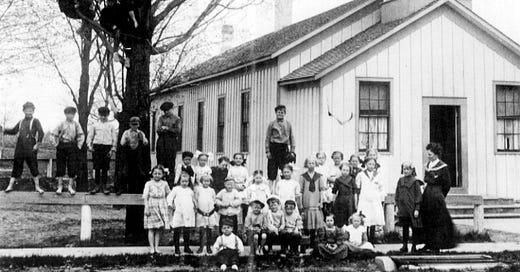Childcare drives school district planning
Improving student outcomes begins when we stop pretending it doesn't
What time should school start?
“Most studies reviewed provide evidence that delaying school start time increases weeknight sleep duration among adolescents, … even with relatively small delays in start times of half an hour or so. Later start times also generally correspond to improved attendance, less tardiness, less falling asleep in class, better grades, and fewer motor vehicle crashes.”1
And yet the average start time for high school in the US is 8 am 2 and the ideal start time for enough teen sleep is no earlier than 8:30. 3
Did you expect me to lead with statistics about kindergarten full vs half day?
The need for safe, caring places for our kids to be lasts long past elementary school. We hope to see our gap-toothed kindergarteners and our angsty teens move from one caring adult to another throughout their day, gradually learning how to navigate the world independently.
That’s why school starts at 7:30 or 8:00 AM. It lets a caregiver double check a chronically late kiddo got to school without interrupting the work day. The buses have time to get back and pick up the younger kids before mom and dad need to leave for work. It’s not what’s best for learning, it’s what best for the child’s care.
Classroom management and caring for children
In 1900, only 6.4% of students successfully completed 12th grade, but by 1940, 50% of young adults had earned a high school diploma. 4 Because of compulsory education laws (Mississippi was the last to pass in 1917) urbanization, new child labor laws, and a budding understanding of childhood developmental needs more students stayed in school longer.
In the years I’ve studied childcare and the US k12 school system what stands out most is the move to the city and the industrial revolution meant there was a notable shift from parents needing children at home to help with manual farm labor, to needing a place for children to be while parents worked away from home.
I think this is the bit the Christensen Institute5 and so many other miss when they talk about the classroom as a factory for producing little workers. Until this massive shift, teachers were expected to keep students for as little time as possible while still accomplishing the days’ lessons and send them back home to help. Now there were more students, defined time blocks, and plenty more kids who didn’t want to be there at all.
Parents were no longer teaching the bulk of the skills students would need for life's work, supplemented by a few hours of reading, writing, and math at school. Kids didn’t have an afternoon of outdoor work to run off their energy. And as far as I can tell, we never really talked about what that does to little brain and bodies, to a teacher’s emotional work load, and to families as a whole.
Instead, the focus was on keeping the peace in this new way of being at school and imparting as many skills as possible to try and help a kid enter a workforce that was brand new to the whole country.
Childcare as the spoken focus of education systems
If we acknowledged a reality where the country relies on 'free' childcare from ages 5-18, and identified that as the primary function of schools, how might funding change?
How would we approach families where there is still a full time care giver in the home? Community members with no children?
What might we require of the employer tax base that benefits from having workers who don’t directly pay for childcare after age 5?
Would the full focus of the day still be academics?
What would we choose to assess?
What additional hires would we make for classrooms?
How would things change if we recognized that school starts at 7:30 because that’s when our nation’s children need caring for while parents are at work?
Bonus: Check out this delightful LIFE feature on one room school houses.
Wheaton AG, Chapman DP, Croft JB. School Start Times, Sleep, Behavioral, Health, and Academic Outcomes: A Review of the Literature. J Sch Health. 2016 May;86(5):363-81. doi: 10.1111/josh.12388. PMID: 27040474; PMCID: PMC4824552.
Sawyer, H., Taie, S., & Westat. (2020, February). Start Time for U.S. Public High Schools. The Institute of Education Sciences. https://nces.ed.gov/pubs2020/2020006/index.asp
Adolescent Sleep Working Group; Committee on Adolescence; Council on School Health. School start times for adolescents. Pediatrics. 2014 Sep;134(3):642 https://pubmed.ncbi.nlm.nih.gov/25156998/
Digest of Education Statistics, 2010. National Center for Education Statistics (NCES) Home Page, a part of the U.S. Department of Education. (n.d.). https://nces.ed.gov/programs/digest/d10/tables/dt10_110.asp
https://www.christenseninstitute.org/k-12-education/



